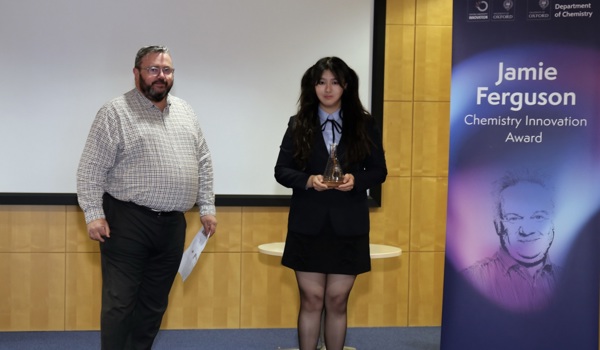Biography
Harrison Steel completed a BEng in Mechanical Engineering and a BSc in Physics and Mathematics at the University of Sydney. He then came to Oxford as a Monash Scholar and completed his DPhil at the University of Oxford as a Monash Scholar. Following his studies he was a postdoctoral researcher in the Department's Control Group, before joining as an Associate Professor in 2020.
Personal website
Most Recent Publications
Streamlined and efficient genome editing in Cupriavidus necator H16 using an optimised SIBR-Cas system
Streamlined and efficient genome editing in Cupriavidus necator H16 using an optimised SIBR-Cas system
Directing microbial co-culture composition using cybernetic control.
Directing microbial co-culture composition using cybernetic control.
Model-guided gene circuit design for engineering genetically stable cell populations in diverse applications.
Model-guided gene circuit design for engineering genetically stable cell populations in diverse applications.
Optimisation strategies for directed evolution without sequencing
Optimisation strategies for directed evolution without sequencing
Computational Synthetic Biology Enabled through JAX: A Showcase.
Computational Synthetic Biology Enabled through JAX: A Showcase.
Research Interests
Harrison Steel's research group works on interdisciplinary challenges at the intersection of Synthetic Biology, Robotics, and Control Engineering.
Synthetic Biology and Feedback Control
Engineered biological systems are often fragile and highly sensitive to changes in their environment. We are building synthetic biological feedback systems to enable robust, safe biotechnologies with applications in fields from agriculture to medicine.
Experimental Robotic Platforms
Cutting-edge experimental tools and methods are integral to enabling research, scale-up and application of engineered biological systems. We develop robotic platforms - some of which are currently used by dozens of academic and industry labs worldwide - to help answer scientific questions and create new biotechnologies.
Theory for Control/Biology
In parallel with experimental work, we frequently work on theoretical questions in control and biology - using mathematics to investigate or simulate systems that would be challenging to analyze in the lab.
Current Projects
- Synthetic Biological Controllers: Modelling and implementing novel feedback control in bacteria.
- Feedback for Experimental Evolution: Building control loops into experimental evolution to steer and accelerate the process.
- Measurement and Control of Microbial Communities: Application focused engineering of methods for real-time monitoring and control of interactions in communities of co-living microbes.
- Bioreactor Development: Building upon the Chi.Bio bioreactor system to develop new capabilities in partnership with industry. Also developing bioreactors that integrate acoustic (ultrasonic) actuation/manipulation of liquids.
Research Groups
Most Recent Publications
Streamlined and efficient genome editing in Cupriavidus necator H16 using an optimised SIBR-Cas system
Streamlined and efficient genome editing in Cupriavidus necator H16 using an optimised SIBR-Cas system
Directing microbial co-culture composition using cybernetic control.
Directing microbial co-culture composition using cybernetic control.
Model-guided gene circuit design for engineering genetically stable cell populations in diverse applications.
Model-guided gene circuit design for engineering genetically stable cell populations in diverse applications.
Optimisation strategies for directed evolution without sequencing
Optimisation strategies for directed evolution without sequencing
Computational Synthetic Biology Enabled through JAX: A Showcase.
Computational Synthetic Biology Enabled through JAX: A Showcase.
Publications
For an up-to-date list of Publications please see my Google Scholar.
Most Recent Publications
Streamlined and efficient genome editing in Cupriavidus necator H16 using an optimised SIBR-Cas system
Streamlined and efficient genome editing in Cupriavidus necator H16 using an optimised SIBR-Cas system
Directing microbial co-culture composition using cybernetic control.
Directing microbial co-culture composition using cybernetic control.
Model-guided gene circuit design for engineering genetically stable cell populations in diverse applications.
Model-guided gene circuit design for engineering genetically stable cell populations in diverse applications.
Optimisation strategies for directed evolution without sequencing
Optimisation strategies for directed evolution without sequencing
Computational Synthetic Biology Enabled through JAX: A Showcase.
Computational Synthetic Biology Enabled through JAX: A Showcase.
DPhil Opportunities
I am always keen to hear from potential graduate students and assist them on their journey to Oxford. If you are thinking of applying please reach out (via email) to discuss our group and your interests/potential projects.
Most Recent Publications
Streamlined and efficient genome editing in Cupriavidus necator H16 using an optimised SIBR-Cas system
Streamlined and efficient genome editing in Cupriavidus necator H16 using an optimised SIBR-Cas system
Directing microbial co-culture composition using cybernetic control.
Directing microbial co-culture composition using cybernetic control.
Model-guided gene circuit design for engineering genetically stable cell populations in diverse applications.
Model-guided gene circuit design for engineering genetically stable cell populations in diverse applications.
Optimisation strategies for directed evolution without sequencing
Optimisation strategies for directed evolution without sequencing
Computational Synthetic Biology Enabled through JAX: A Showcase.
Computational Synthetic Biology Enabled through JAX: A Showcase.





